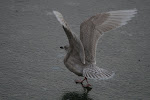 Chris and I joined Tony Cross and Adrienne Stratford at a heronry in North Wales where Tony climbed the pine trees and brought down 4 Little Egret chicks! They have quite a 'stab' on them, hence why I am holding them away from my face...I value my eyes!
Chris and I joined Tony Cross and Adrienne Stratford at a heronry in North Wales where Tony climbed the pine trees and brought down 4 Little Egret chicks! They have quite a 'stab' on them, hence why I am holding them away from my face...I value my eyes! This bird was the largest of the brood and was absolutely stunning! This is close to adult size, so in hand, you can fully appreciate why they are called Little Egrets. The best bird I have ringed so far...by far!
This bird was the largest of the brood and was absolutely stunning! This is close to adult size, so in hand, you can fully appreciate why they are called Little Egrets. The best bird I have ringed so far...by far! Being in the colony itself was an almost prehistoric experience as the gloomy pine floor looked like a scene from Jurassic Park and the screech of Grey Heron and Little Egrets were almost Velociraptor-esque!
Being in the colony itself was an almost prehistoric experience as the gloomy pine floor looked like a scene from Jurassic Park and the screech of Grey Heron and Little Egrets were almost Velociraptor-esque! We got up at 05.30am in order to complete the daily Pied Flycatcher survey for Chris' dissertation project, so I am wondering whether today's events actually happened, or was it just an exhausted hallucination!?!?
We got up at 05.30am in order to complete the daily Pied Flycatcher survey for Chris' dissertation project, so I am wondering whether today's events actually happened, or was it just an exhausted hallucination!?!?We ended the day at 10pm with the ringing of 2 Chough broods which added to an amazing day.
A massive thanks to Adrienne and Tony for inviting me and also congratulations to Chris for finding his first Wood Warbler and Tree Pipit nests!
The Little Egret Project.
Tony Cross, Kelvin Jones and Adrienne head into the Heronry every June and colour-ring the young. The two that I personally ring were white 'L' on the left leg and yellow 'B' on the right, as well as white 'L' on the left and yellow 'D' on the right. (Hopefully these will turn up somewhere a little sunnier than North Wales!
Tony was telling Chris and I that there have been some really interesting recoveries, all of which from the north or west apart from the bird photographed above which was seen in Tenerife in November after being ringed in mid-June! Reports have come from a range of places from Lancashire to Northern Ireland.
Please report any colour-ringed Little Egrets to the BTO to further our knowledge of individual bird movements.

No comments:
Post a Comment